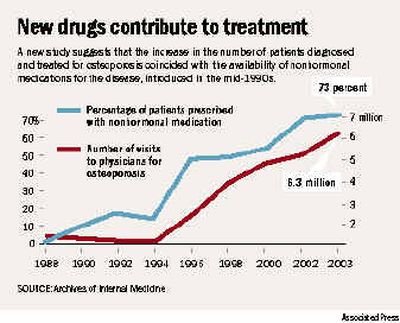Osteoporosis cases rise as care improves

CHICAGO – The number of Americans diagnosed with osteoporosis surged sevenfold over the past decade, coinciding with the development and marketing of new drugs to treat the bone-thinning condition, a study has found.
As of last year, an estimated 3.6 million people had been diagnosed with osteoporosis compared with half a million in 1994, according to the study by Stanford University researchers. Also, the number of doctor visits for the condition jumped to 6.3 million last year from 1.3 million in 1994.
The increases coincided with the introduction of the bone-protecting drugs alendronate, sold as Fosamax, in 1995; raloxifene, or Evista, in 1997; and risedronate, or Actonel, in 1998.
All three are among the nonhormonal alternatives to estrogen supplements, which have long been used to prevent osteoporosis but have lost popularity because of recent studies linking them to heart problems, breast cancer and other risks.
In 1988, estrogen was prescribed at 35 percent of osteoporosis-related doctor visits, but that fell to 3 percent last year, the study found.
The estrogen alternatives have grown into a multibillion-dollar-a- year industry with widespread ads and slick promotional campaigns that have helped raise awareness about osteoporosis. The researchers said that probably helped increase diagnosis rates.
Partly because of the newer drugs, “the whole way that we think about osteoporosis has shifted … to one of prevention,” said Dr. Randall Stafford, who led the study. “We hope to catch it early enough to treat it early enough to prevent fractures.”
Nevertheless, osteoporosis remains underdiagnosed and undertreated, said Dr. Ethel Siris, head of the National Osteoporosis Foundation’s science and research committee.
The study’s authors said new guidelines recommending universal screening for women 65 and older may further improve diagnosis and treatment.
The study appears in Monday’s Archives of Internal Medicine.
Stafford and colleagues analyzed data from a physician survey conducted by IMS Health, a health care information company. About 3,500 randomly selected doctors participate each quarter in the survey.
Prescriptions for calcium, an older standard treatment for osteoporosis, fell during the study period. The authors had no data on sales of over-the-counter calcium pills. Stafford said the decrease is a concern, because calcium remains an important way of helping to prevent osteoporosis.
Siris agreed. Getting calcium and vitamin D – either through diet or supplements — and exercising “are part of the package” for preventing osteoporosis, she said. “Those things are cheap and easy.”